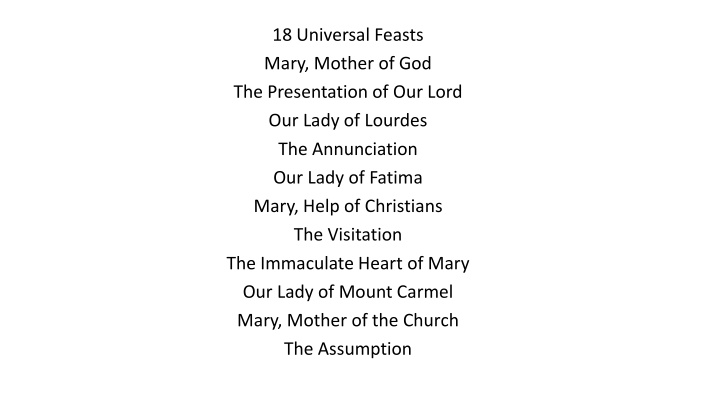



18 Universal Feasts Mary, Mother of God The Presentation of Our Lord Our Lady of Lourdes The Annunciation Our Lady of Fatima Mary, Help of Christians The Visitation The Immaculate Heart of Mary Our Lady of Mount Carmel Mary, Mother of the Church The Assumption
The Queenship of Mary The Nativity of Mary The Most Holy Name of Mary Our Lady of Sorrows Our Lady of the Rosary The Presentation of Mary The Immaculate Conception
There are a further six feasts in which Mary is honoured indirectly: Sts Joachim and Ann Christmas Epiphany St Joseph, Spouse of Mary The Holy Family The Holy Innocents
There are ONLY ten statements made about Mary in NT: 1. Annunciation 2. Visitation 3. Nativity 4. Presentation 5. Refugee to Egypt 6. Loosing of Jesus in the Temple 7. Goes to bring Jesus home from his public ministry (Mk3) 8. Cana 9. Crucifixion 10. Pentecost
Wedding feast of Cana. • On first reading it could seem Mary & Jesus just liked a party. • John 2:6 “standing nearby were six water jars which held 20- 30 gallons of water each.” • So that’s 120 – 180 gallons or given today’s bottles that would be 75 dozen or 900 bottles of wine. • The details of this story are are lost on us today. • Wine on the OT is always a sign of joy; • The wedding banquet is always a metaphor for the marriage of heaven and earth. • And why does Mary ask Jesus for the miracle? To save them shame. Even now to run out of wine at a wedding would be socially embarrassing. In Jesus day….
• We have to admit that the memory of Mary has been misused by generations of men in the Church to outline a role for women which has been secondary, compliant, subjective, ancillary. • In the Magnificat, however, Mary is none of these. She stands as a model of liberation for all people in Christ. • Mary is fully and truly human • Mary needed God’s redemption in Christ • While Mary received unique gifts in her Assumption the doctrine also says that as God remained faithful to her God will remain faithful to us.
• Mary is pre-eminent disciple of Jesus’ Kingdom • The stories about Mary in the New Testament have something to say to those who are • Teenage mothers • Poor, hard working religious people • A refugee • A so-called person of colour • She gives consolation to parents who cannot work out their children , who ever lost a child in the market place or have through the heart-break of loosing a child in death • Mary always and everywhere leads us to Jesus.
Apparitions and Revelations • Congregation for Doctrine of the Faith, 1978: “The Norms Presumed Apparition and Revelations” • You can be a Catholic in full and true standing with the Church and not believe in one of them • They are private revelations, the status of personal religious experiences, from which others have found great comfort and support in their own faith. • “If it helps, do it. If it doesn’t, don’t”
Know the important elements of the tradition • 1st Century Mary is model disciple in Luke and Matthew Mary is the Mother of the early Church in John • 2nd Century Justin Martyr calls Mary the New Eve, argues Revelation 12 describes Mary • 235 Hippolytus Mary was sinless • 436 Ephesus Mary is the Theotokos, the ‘God carrier’ • 6th Century Syria celebrates Mary’s Immaculate Conception • 6th Century Eastern Feast of Mary ‘falling asleep’
• 8th Century John of Damascus teaches that Mary’s body was assumed into heaven • 12th Century Bernard of Clairvaux argues Mary has powerful interceding role • 12th Century Immaculate Conception is a Feast in the Church at Lyon
• 1854 Pius IX defines the teaching of the Immaculate Conception of Mary • 1950 Pius XII, in the last infallible teaching of a Pope, defines the Assumption of Mary • 1961 Vatican II rejects writing a free standing document about Mary, but writes a chapter about Mary within its teaching on the Church • As the tabernacle goes back, the Marian Shrine comes forward!
Recommend
More recommend